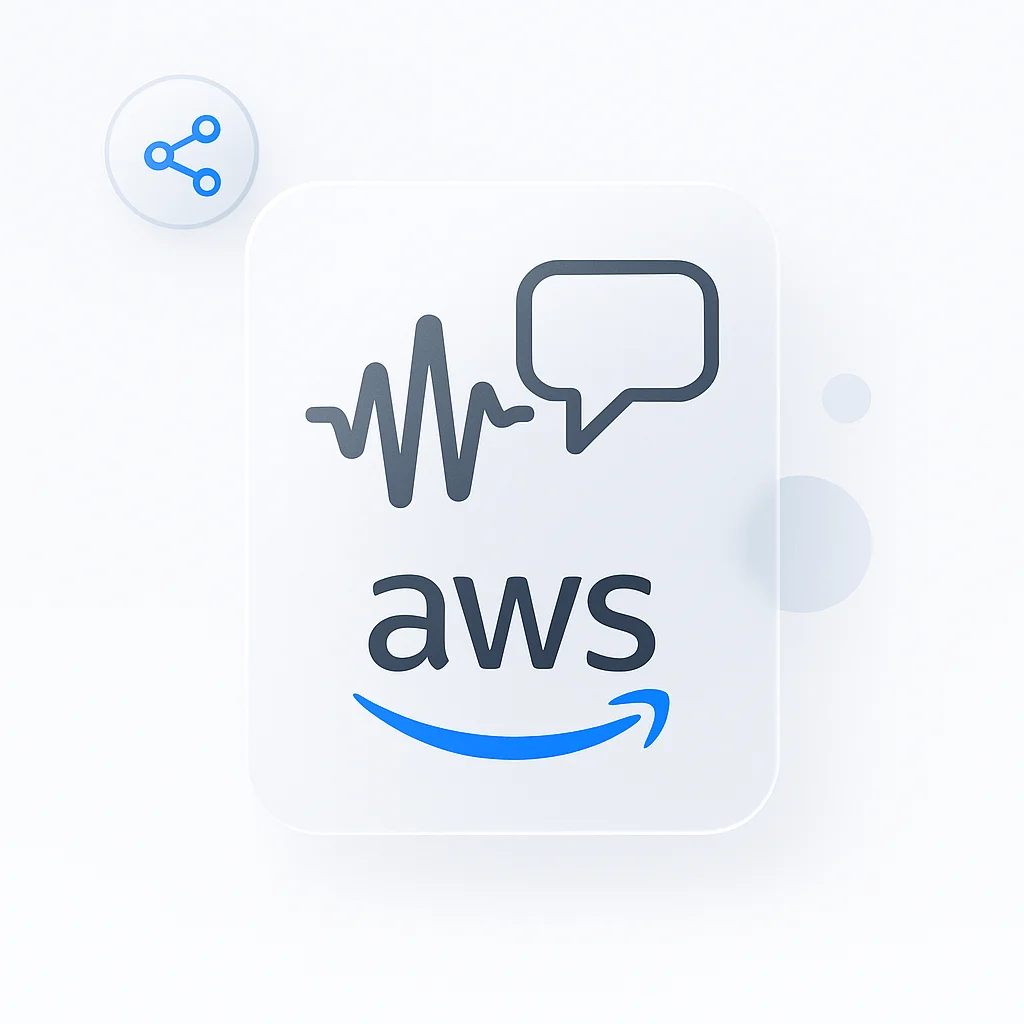Você está pronto para desbloquear o poder do Amazon Transcribe e do Amazon Web Services (AWS)? Não procure mais! Este guia abrangente é o seu recurso definitivo para navegar no mundo da transcrição e da computação em nuvem. Seja você um profissional experiente ou apenas começando, nós o ajudamos com instruções passo a passo, dicas de especialistas e exemplos do mundo real. Prepare-se para revolucionar seu fluxo de trabalho e levar seus projetos a novos patamares com a dupla dinâmica do Amazon Transcribe e AWS. Vamos mergulhar!
Introdução
A transcrição de áudio está na vanguarda dos avanços tecnológicos que melhoraram muito a vida cotidiana dos seres humanos nas últimas décadas. A conversão da linguagem falada em texto escrito revolucionou a forma como as pessoas trabalham em vários setores. O Reconhecimento Automático de Fala (ASR), em particular, é um componente bastante comum desse conceito, auxiliando-nos de várias formas, como por meio de assistentes virtuais em nossos dispositivos móveis e em aplicativos de aprendizado de idiomas. As ferramentas de transcrição aumentaram a acessibilidade e permitem o armazenamento e a análise eficientes de dados em um espectro de diferentes campos.
Entre os muitos serviços de transcrição disponíveis para o público em geral, o Amazon Transcribe se destaca como um serviço inovador e versátil. Ele fornece soluções robustas para uma infinidade de empresas, bem como para indivíduos que buscam desenvolver a transcrição automatizada de áudio. Neste artigo, tentamos abordar os detalhes intrincados que compõem o Amazon Transcribe, bem como a sinergia que ele tem com o Amazon Web Services (AWS). Também daremos uma breve olhada na computação em nuvem e nos principais recursos do Amazon Transcribe que o tornam uma ferramenta ideal para uso generalizado.
Amazon Transcribe
O Amazon Transcribe é um pioneiro no campo de serviços de transcrição com suporte tecnológico e foi projetado para formar transcrições escritas de palavras faladas, com foco principal em garantir a conversão suave de áudio em texto. As transcrições criadas deveriam ser legíveis e compartilháveis, com espaço para análise e pesquisa de palavras, quando necessário. O Amazon Transcribe, assim como a maioria das ferramentas baseadas em IA da era moderna, impulsiona a eficiência e aumenta a acessibilidade em todos os níveis para todos os tipos de usuários.
É amplamente utilizado em muitos domínios, mas principalmente nas seguintes áreas:
- Aumentar a acessibilidade para usuários com deficiência
- Transcrição de conferências e entrevistas gravadas
- Para fins de indexação e arquivamento de conteúdo
O Amazon Transcribe é diverso em sua concepção e atende à crescente necessidade de transcrição simplificada, garantindo que sua conexão com o Amazon Web Space forneça aos usuários acesso fácil às transcrições criadas.
Principais recursos
Tecnologia de Reconhecimento Automático de Fala (ASR)
O Reconhecimento Automático de Fala (ASR) é um componente chave do Amazon Transcribe, pois é treinado para identificar padrões de fala, palavras e frases faladas e é capaz de classificá-las com precisão de acordo. Ele equipa algoritmos de aprendizado de máquina para reconhecer sotaques e flutuações de tom, a fim de garantir a máxima precisão.
Transcrição Multilíngue e Específica do Domínio
O Amazon Transcribe é uma ferramenta universal que atende a vários idiomas e garante que ele seja versado em nichos de mercado. É altamente aplicável a vários setores, pois os modelos de linguagem são ajustados à área específica, de forma que sejam capazes de identificar jargões especializados e criar transcrições precisas, independentemente do contexto.
Vocabulário personalizado e opções de modelo de linguagem
As opções de modelo de linguagem disponíveis no Amazon Transcribe são ilimitadas, dados os constantes avanços que estão sendo feitos regularmente. As empresas podem aumentar a precisão das transcrições produzidas, empregando desenvolvedores para alimentar e personalizar o vocabulário mais alinhado com seu setor, de modo que termos e terminologias específicas do domínio não sejam perdidos na transcrição. Para obter orientação adicional sobre como gerenciar configurações técnicas ou alinhamento de terminologia, recursos como a Central de Ajuda do Dynadot podem ser úteis, especialmente ao integrar ferramentas de transcrição com fluxos de trabalho relacionados ao domínio.
Transcrição em Tempo Real e Processamento em Lote
O Amazon Transcribe é capaz de fornecer transcrição em tempo real, bem como processamento em lote, a fim de maximizar a transcrição e atender às demandas necessárias. A transcrição em tempo real é um trunfo que é mais importante durante eventos ao vivo, pois garante que todos os membros do público possam acessar o conteúdo quase instantaneamente. O processamento em lote é de particular importância onde grandes quantidades de dados precisam de transcrição em um curto período de tempo; em vez de gastar recursos para executar transcrições paralelas, processá-lo em lotes economiza tempo e esforço.
Aprendizado de Máquina
Os serviços de transcrição dependem do aprendizado de máquina para acelerar o processo, bem como garantir a precisão. O Amazon Transcribe não é diferente; ele emprega o aprendizado de máquina para garantir avanços constantes na transcrição, para melhorar a precisão, bem como a eficiência. Ele implementa a ideologia de que a prática leva à perfeição, aprendendo a se adaptar à linguagem de nicho usada com cada nova transcrição. Quanto mais dados são processados por meio desse sistema, mais precisa a transcrição se torna com o tempo. Isso garante que o Amazon Transcribe possa atender aos requisitos de qualquer empresa e ser considerado um provedor de serviços confiável.
Computação em Nuvem
Em nosso mundo em rápida digitalização, a tecnologia prevalece como uma solução para a maioria dos problemas que enfrentamos. Seja calculando impostos, fazendo horários ou criando código, a tecnologia avançada auxilia nosso progresso. Um desses componentes da tecnologia menos falado, mas amplamente utilizado em todo o mundo, é a Computação em Nuvem, um serviço que revolucionou a forma como armazenamos nossos dados.
A dependência de hardware local não é uma opção tão viável ultimamente, dada sua capacidade limitada e, francamente, a volumosa roupa exterior. O armazenamento interno é frequentemente ainda menos considerado, dados os complexos aros que se deve passar para garantir que arquivos maiores estejam seguros e não totalmente desfigurados no processo de compressão frequentemente exigido.
Os serviços de nuvem são flexíveis e abrangem uma variedade de serviços pela internet. Estes incluem armazenamento e rede, com um foco específico em poder de computação, bem como análise. As empresas otimizam suas operações implementando uma arquitetura de nuvem robusta e aproveitando o gerenciamento multicloud para garantir um gerenciamento de dados e escalabilidade do sistema perfeitos. A computação em nuvem permitiu que os usuários fossem menos dependentes de hardware físico e facilitou a navegação por meio de software. Os usuários podem acessar e utilizar recursos por meio de provedores de serviços de nuvem no conforto de suas próprias casas, com pouco ou nenhum conhecimento na área; tudo o que eles realmente precisam é uma conexão estável com a internet.
Como funciona o AWS?
O Amazon Web Services é uma plataforma de computação em nuvem que oferece uma variedade de serviços para uma ampla gama de setores: de empresas a desenvolvedores profissionais e indivíduos que podem buscar seus serviços para uso pessoal. O AWS é versátil e flexível, permitindo o crescimento e o gerenciamento de aplicativos. Para fazer isso, ele emprega os seguintes componentes:
Componentes do AWS
Infraestrutura Global
O AWS é considerado uma plataforma global, pois abrange uma variedade de regiões conhecidas como ‘Zonas de Disponibilidade’, onde existem data centers físicos separados para armazenar dados e habilitar o funcionamento em rede. É altamente disponível e tolerante a falhas devido a esses centros.
Serviços Oferecidos
Os serviços fornecidos pelo AWS são extensos e podem variar de Armazenamento por meio do Amazon S3 ao Poder de Computação por meio do Amazon EC2. Ele também inclui a retenção de banco de dados por meio do Amazon RDS e seu próprio gerenciador de aprendizado de máquina amplamente conhecido como Amazon SageMaker. A combinação desses serviços permite que os clientes atendam a requisitos específicos e forneçam a eles soluções personalizadas para quaisquer problemas que possam encontrar.
Console de gerenciamento da AWS
O Console de Gerenciamento da AWS é uma interface web que permite o gerenciamento de outros serviços da AWS. É considerada uma interface unificada e bastante fácil de usar, que atua como um hub centralizado para monitorar e escalar recursos, bem como configuração. Entender os preços do AWS S3 pode ajudar a otimizar a relação custo-benefício dentro do Console de Gerenciamento da AWS.
AWS Identity and Access Management (IAM)
O Identity and Access Management da AWS (IAM) é um componente integrante do sistema, pois garante que os usuários possam gerenciar e autorizar o acesso aos seus dados dentro dos serviços da AWS.
Integração com o Amazon Transcribe
Utilização da Infraestrutura
A integração do Amazon Transcribe com o AWS traz uma infinidade de benefícios, começando com a infraestrutura global e bastante extensa do AWS, que auxilia na transcrição eficiente dentro do Transcriber. Este aspecto particular garante a confiabilidade das transcrições, independentemente do volume de informações e para quem se destinam a ser compartilhadas.
Soluções de Armazenamento (S3)
As capacidades de computação em nuvem da AWS são mais proeminentes no componente Amazon S3, que atua como um serviço de armazenamento simples. Ele é usado pelo Amazon Transcribe para garantir o armazenamento seguro de arquivos de áudio, bem como suas transcrições correspondentes. O Amazon S3 é durável, o que o torna uma excelente escolha para armazenamento e garante que as transcrições sejam protegidas e acessíveis para uso do cliente.
Integração com outros serviços (AWS Lambda)
A integração dos serviços AWS incentiva a produtividade e um fluxo de trabalho mais suave, especialmente com componentes como o Lambda, que computa e automatiza tarefas que seguem uma transcrição, de forma que os clientes possam extrair trechos da transcrição e as funções Lambda permitem que sejam usados em outros contextos. As empresas podem contratar especialistas em tecnologia por meio de empresas como a Smoothstack Inc para acessar profissionais qualificados para gerenciar integrações complexas.
Benefícios de usar o Amazon Transcribe e o AWS
O Amazon Transcribe e o AWS existem como serviços individualmente brilhantes que, quando integrados, trazem uma extensa lista de benefícios destinados a muitos setores, com muitos casos de uso para apoiar as alegações. A relação dinâmica entre o transcribedor e o serviço de computação existe como resultado do ecossistema construído pela Amazon para gerar serviços de transcrição eficientes e benéficos em todo o mundo.
Relação Custo-Benefício
A implementação de um modelo de preços pay-as-you-go garante que as cobranças feitas no Amazon Transcribe sejam apenas para os serviços que os clientes utilizam em tempo real, de forma que não haja necessidade de investimentos volumosos antes do uso. Isso garante que as empresas possam otimizar o uso do Amazon Transcribe e alocar os orçamentos necessários de acordo com a urgência da transcrição.
Escalabilidade
O AWS fornece ao Amazon Transcribe uma escalabilidade incomparável pela maioria dos serviços de computação em nuvem, pois é capaz de se adaptar às mudanças dinâmicas na demanda, dependendo da necessidade de transcrição. A elasticidade do AWS aumenta a capacidade do transcriber de fornecer transcrições precisas e eficientes com um atraso muito mínimo (se houver) do lado deles. Isso também ajuda a garantir que haja sempre uma compreensão clara da disponibilidade de recursos e o desempenho seja mantido de forma linear.
Flexibilidade e Personalização
Os serviços que existem dentro da plataforma AWS agregam um valor tangível ao Amazon Transcribe, especialmente ao fornecer flexibilidade para combinar serviços complementares quando necessário e permitir a personalização dos serviços para se adequar à empresa com a qual podem estar trabalhando. Isso ajuda a construir um fluxo de trabalho que atenda a demandas específicas, ao mesmo tempo em que garante a eficiência por meio de transcrição automatizada e processamento de dados simplificado. Da mesma forma, as empresas geralmente adotam ferramentas especializadas, como software de gerenciamento de ativos, para obter visibilidade centralizada sobre recursos físicos e digitais, melhorando o rastreamento, relatórios e produtividade operacional geral.
Segurança
A natureza segura do AWS garante que os dados dentro do Transcriber sejam protegidos. O AWS está equipado com medidas de segurança que atendem aos padrões da indústria, especialmente onde dados confidenciais podem ser transcritos. Ele emprega criptografia de dados, bem como proteção de rede para garantir que as informações transcritas e armazenadas sejam mantidas confidenciais.
Inovação
O Amazon Transcribe está em constante avanço, a fim de acompanhar as crescentes demandas dos clientes, bem como a natureza rapidamente inovadora do aprendizado de máquina. O AWS garante que ele permaneça atualizado e seja integrado aos serviços necessários para melhorar a precisão das transcrições criadas, de modo que estejam em linha com o uso no mundo real e coincidam com o nicho de mercado para o qual podem ser feitas.
Conclusão
Com cada avanço e integração de novos componentes, o Amazon Transcribe está revolucionando a forma como processamos informações e como integramos o conteúdo falado em nossos negócios, bem como no desenvolvimento profissional. A conversão de fala em texto ajudou vários setores, reduzindo pela metade o tempo necessário para entender conceitos, obter insights e colaborar. Isso é especialmente verdadeiro quando o Reconhecimento Automático de Fala (ASR) é usado como um meio de garantir que o processo de transformar palavras faladas em algo tangível e útil seja mantido bastante simples.
As capacidades do Amazon Transcribe são diretamente influenciadas por sua integração com o Amazon Web Services (AWS), que consiste em uma variedade de serviços específicos para otimizar o processo de transcrição. Embora originalmente um serviço de computação em nuvem, o AWS está equipado com infraestrutura padrão e outros serviços que garantem ótimo desempenho, bem como segurança robusta. O Amazon Transcribe é capaz de aproveitar os poderes do AWS para criar transcrições que podem ser facilmente integradas a outros serviços complementares.
Essas ferramentas existem dentro de um ecossistema criado pela Amazon para atender a profissionais e usuários individuais, preenchendo a necessidade de transcrição e expandindo seu alcance em todo o mundo com recursos como recursos multilíngues e aprendizado de máquina que o equipam com o conhecimento necessário para estender seus serviços até mesmo aos nichos de mercado.
Entender a forma como o Amazon Transcribe, bem como o AWS, funcionam é fundamental para tomar decisões práticas sobre as ferramentas de transcrição com as quais você se envolve como cliente. Explorar suas capacidades e experimentar sua extensa lista de recursos o ajudará a determinar se o Amazon Transcribe e o AWS podem ajudar a elevar seu negócio a longo prazo.
Para maximizar a eficiência do Amazon Transcribe, as empresas geralmente contratam engenheiros AWS especializados em serviços de IA da AWS. Esses profissionais podem ajustar a precisão da transcrição, integrar o processamento de fala em tempo real e gerenciar soluções de armazenamento em nuvem econômicas.






